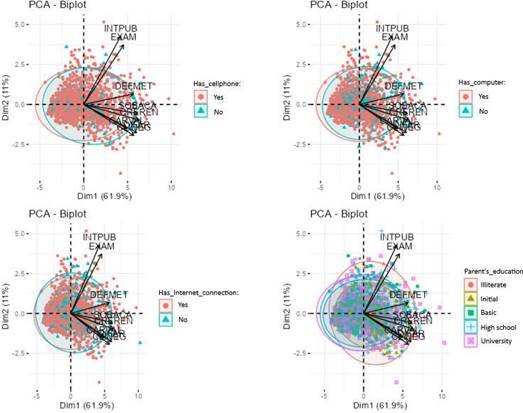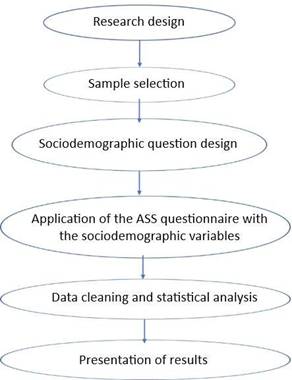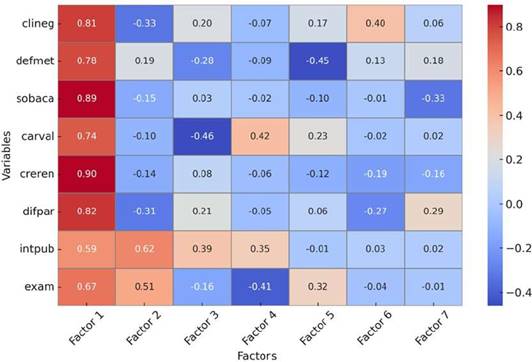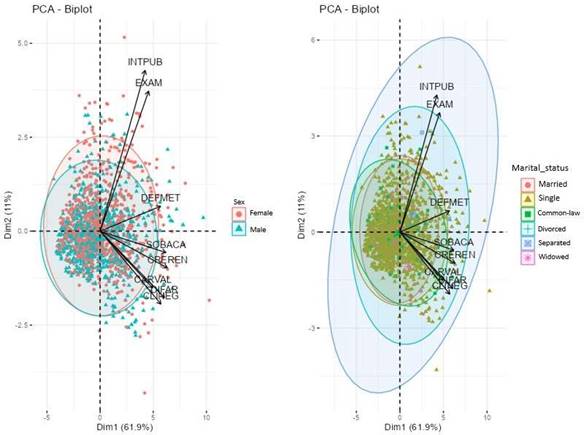I. INTRODUCTION
Stress, understood as an adaptive response to external pressures, has evolved from its origins in physics- where it referred to forces acting on objects-to become a multidimensional phenomenon studied across disciplines such as medicine, psychology, and education. Today, the study of stress has gained renewed attention due to the demands of competitive societies, where the quest for academic and professional excellence places unprecedented pressure on individuals. This shift has prompted a reevaluation of stress, viewing it not just as a biological response but as a reflection of the constantly changing educational and work environments.
In the context of universities, stress emerges as a significant issue, exacerbated by the convergence of two primary forces: increasing academic demands and expectations from the global labor market. Students are required not only to master academic content but also to develop soft skills, gain practical experiences, and build a competitive personal brand. This duality creates a situation where academic performance is seen as a direct predictor of future job opportunities, intensifying both emotional and cognitive burdens. Recent research highlights how this pressure manifests in various factors, ranging from task overload to anxiety about future employability, thereby creating a cycle where academic stress and job expectations continuously reinforce one another.
Academic stress is influenced by many factors, including biological, psychosocial, psycho-socio-educational, and socioeconomic moderators 3. These encompass a diverse range of variables including demographic factors (age, sex), psychological resources (coping strategies, academic self-concept), social factors (support networks), educational parameters (type of studies, course), environmental conditions (place of residence, internet access), and financial circumstances (scholarship status). These variables affect the stress process comprehensively, from the initial appearance of stressors to their ultimate consequences, thereby influencing how individuals approach stressors and their likelihood of managing them effectively. The most prevalent academic stressors include excessive homework and insufficient time to complete academic activities, assessments, and required assignments.
Previous research 4 has demonstrated that the primary factors contributing to academic stress are methodological deficiencies among teaching staff, academic overload, performance-related beliefs, public interventions, negative social climate, individual examinations, perceived lack of content value, and participation difficulties. Notably, factors associated with teaching methodologies demonstrated the highest incidence and relevance, with statistical significance exceeding other factors.
The analysis of emotional regulation profiles in students has revealed that the main academic stressors are public interventions, exams, and deficiencies in teaching methodologies, followed by academic overload 5. Physical exhaustion was the most commonly reported psychophysiological response. Furthermore, subsequent studies have revealed significant variations in stressor perception across different emotional profiles 6.
Research on the influence of goal orientation on the perception of academic stressors and psychophysiological responses to stress in college students 2 has found that performance-avoidance orientation is associated with higher levels of academic stressors, particularly about overload, performance beliefs, public interventions, and exams. Students with this orientation perceived an increased threat to these stressors and experienced more intense psychophysiological responses 7, such as physical exhaustion and intrusion of negative thoughts.
Additional research has demonstrated a high prevalence of academic stress, particularly among female students 8. The primary stressors identified were instructor evaluations and excessive homework demands, while the most commonly reported symptoms included drowsiness and impaired concentration. Significant variations were also observed in evaluation perception, with notable differences correlating with students' chosen fields of study.
Investigations into the efficacy of preventive measures addressing academic stress identified examinations and imminent assessment deadlines as principal triggers 9. Other significant factors included inconsistencies in assignment requirements and misalignment between examination content and instructional material. Moreover, limited access to information and communication technologies (ICTs) emerged as a stressor. Although excessive technological engagement can diminish social interaction and generate psychosocial risks 10, appropriate technological integration enhances student productivity and efficiency. Consequently, inadequate ICT access can adversely impact academic performance 11. The research further established that stress susceptibility increased with age, with older individuals exhibiting heightened anxiety regarding academic tasks.
The prevalence of stress among medical students reveals a substantial incidence, particularly at moderate and high levels 12. This stress manifests more frequently among female students, with peak levels observed predominantly during initial and final academic cycles. Factors most strongly associated with stress included final examinations, poor academic performance, instructor evaluations, and constrained timeframes for assignment completion. Although these factors demonstrated significant associations with stress manifestation, only severe stress levels exhibited a measurable correlation with diminished academic achievement.
This study aims to characterize stress patterns in university students, employing factor analysis to evaluate relationships between stress manifestations and socioeconomic variables, including age, gender, and parental educational attainment. The investigation commences with a comprehensive approach addressing academic stress as a multifaceted phenomenon, supported by an extensive review of international, regional, national, and local research. Subsequently, the theoretical framework underpinning the analysis is delineated, followed by a comprehensive methodological exposition and thorough presentation of results with corresponding interpretations. The study concludes by highlighting significant findings that contribute novel insights regarding stress-inducing factors among university students, with implications for both academic policy and student support services.
II. DEVELOPMENT
A. Factor Analysis
FA is a statistical technique that identifies unobservable factors that explain the relationships between variables, thus reducing the number of variables. These factors help simplify the data by identifying latent dimensions that effectively represent the original variables. The AF is based on principles of linear regression and partial correlation to fit the data to the structure of the underlying factors. Its application involves selecting the indicators, determining the extraction method and the amount of factors to be retained, choosing the most appropriate rotation, and evaluating the quality of the solution obtained.
FA is a technique widely used in systematic behavior research and psychological processes. Originally, it was applied in studies on intelligence, temperament, and personality. But today its use has spread to all areas of psychology, as well as to other human and social sciences 14.
B. Definition, Origin, and Evolution of Stress
The definition of stress has evolved significantly, with various interpretations and applications across different fields 15. Initially, the term referred to the stress and deformation experienced by materials under external forces. In medicine, the concept of stress was incorporated as the need to maintain the internal stability of the organism to ensure its proper functioning. A significant advance in its understanding was the development of the General Adaptation Syndrome (GAS), which characterized stress as a non-specific physiological response of the organism to various demands aimed at adapting to changing conditions and preserving internal and external equilibrium. A crucial advance in its understanding was the development of the General Adaptation Syndrome (GAS), which defined stress as a non-specific response of the organism to all kinds of demands to adapt to changing conditions and maintain internal and external equilibrium. Over time, the theory expanded to include the physical factors, social demand, and environmental threats requiring adaptation. By the mid- twentieth century, the concept was revised and recognized as a stimulus and a response of the organism, introducing the term "stressor" to refer to situations, thoughts, or emotions that elicit this reaction.
C. Conceptualization of academic stress: stressors and their consequences
Academic stress, defined as excessive stress during educational periods, affects students at all levels, from preschool to graduate education. It is a systemic and essentially psychological process that arises when students face perceived stressful demands in the school environment. This stress manifests as an imbalance that generates physical and emotional symptoms, leading students to adopt coping strategies to restore balance.
From a psychosocial approach, the triggers of academic stress include physical, emotional, and relational aspects. Three main stressor groups are identified: assessments, work overload, and the conditions of the teaching-learning process. The consequences of stress can be severe, affecting physical and mental health with disorders such as anxiety, depression, and even suicidal behaviors 4.
Stressors increase the risk of health problems and can negatively impact the academic performance of college students. While many studies highlight the adverse effects of stress on performance, others highlight its role in activating the alertness needed to cope with challenges. Students use coping strategies such as confrontation, planning, and seeking social support to manage stress. Generally, academic stress is an inherent part of the educational process, but it can be effectively managed through adaptive strategies 16.
III. METHODOLOGY
This cross-sectional study responds to the growing international concern regarding the impact of academic stress during the transition to higher education, a phenomenon characterized by shared challenges and contextual nuances across regions such as Latin America, Europe, and Asia 2. Employing an integrative methodological approach, the study combines standardized instruments with key sociodemographic variables to identify stress patterns among university students.
The investigation analyzed a stratified cohort of 1,600 students from a public institution of higher education in Ecuador. To preserve confidentiality, all data were anonymized before analysis. The sample reflected common socioeconomic conditions, with participants coming mostly from rural or suburban areas and households with incomes below the average basic wage, along with a balanced gender distribution (57% female and 43% male).
For data collection, the Academic Stressors Scale (ASS) was employed and validated across 12 countries 4. Its 54 items are organized into 8 dimensions: academic overload, methodological deficiencies of professors, public speaking, negative social climate, lack of control over one's performance, perceived irrelevance of course content, participation difficulties, and assessments.
The instrument incorporated standardized sociodemographic variables, including age, sex, parental education level, housing conditions, income, occupational status, marital status, and access to technological resources. Data collection was executed under a supervised quality control protocol, designed to minimize selection bias and enhance internal validity. Subsequently, the database underwent a rigorous cleaning process, applying exclusion criteria based on logical consistency analysis and outlier detection using the interquartile range method (IQR ≥ 1.5), thus ensuring data integrity for inferential analysis, as shown in Figure 1.
IV. RESULTS
The sample was composed of university students with a distribution of 57% female (912) and 43% male (688). The age of the participants ranged from 17 to 23 years. Most of the students were single, representing 91.6% of the total. As for the educational level of the parents, those with high school education predominated (32.7%), followed by university education (28.5%) and basic education (26.4%).
Exploratory PA allowed us to identify underlying dimensions of academic stress in university students. In Figure 2, the heat map of factor loads shows the relationship between the evaluated variables and the extracted factors. It is observed that factor 1 (academic overload and adverse social climate) presents high factor loadings on the variables academic overload (SOBACA: 0.89), belief in performance (CREREN: 0.90), adverse social climate (CLINE: 0.81), and participation difficulties (DIFAR: 0.82), suggesting that this factor is strongly associated with the perception of academic demands and social environment. Factor 2 (methodology and academic content), represented by methodological deficiency (DEFMET: 0.78) and lack of value in the contents (CARVAL: 0.74), reflects concerns related to teaching and the perception of the usefulness of the knowledge taught. Finally, Factor 3 (evaluations and public exposure), characterized by exams (EXAM: 0.67) and public interventions (INTPUB: 0.59), indicates the impact of stress associated with evaluation instances and participation in the classroom. Academic overload and the social environment are the main predictors of stress in students, followed by methodological and evaluative factors, which have direct implications for formulating strategies to mitigate its impact on academic performance.
Figure 3 displays, on the left factorial plane, the relationships between the various dimensions of academic stress and their association with latent factors. The data reveals that academic stress levels are lower in male students compared to female students, with this disparity being particularly pronounced in dimensions related to teacher interactions, clustered in factor 1. Variables such as "teacher methodological deficiencies," "student overload," and "evaluations" demonstrate a strong correlation with stress experienced by female students.
When analyzing marital status at the right factorial level, it is observed that single and married students exhibit relatively lower levels of stress compared to those who are separated or widowed. In the latter group, academic stress demonstrates a stronger association with teacher-related variables, suggesting that these dimensions have a significant impact on stress perception, particularly in contexts of greater emotional vulnerability, such as among separated or widowed students. These findings underscore the importance of directing efforts toward improving teacher-student interactions and managing academic workloads, especially for groups that demonstrate higher susceptibility to stress.
Figure 4 presents factorial planes illustrating the distribution of study variables in relation to ICT tool availability and parental educational levels. Among the variables examined were parents' educational attainment, access to technological devices, and participants' marital status. The graph labels represent various observed categories, including "high school," "basic," "college," "have a computer," "own a cell phone," and different marital statuses, among others.
The first factor, primarily associated with technological variables and parental educational level, accounts for greater variability in the analyzed dimensions compared to factor 2. On the left side of the lower right factorial plane, categories such as "high school," "basic," and "internet connection" cluster together, suggesting that students whose mothers have basic or high school education levels and who have internet access share similar characteristics. These variables position closer to the origin of the axes, indicating moderate variation relative to other variables.
In contrast, toward the right side of the map, the categories "initial" and "illiterate" appear, reflecting greater differentiation with respect to other variables. This dispersion suggests considerable distance in terms of educational access and technological conditions, evidencing potential disparities in preparation level and resource accessibility among different student groups.
The factorial plane also illustrates the distribution of variables related to ICT availability and parental educational attainment. It analyzes how these variables associate with students' sociodemographic characteristics and how they interrelate within the academic context, providing a more comprehensive view of their impact on the educational experience.

Fig. 4 Factorial plot of the study variables vs. availability of ICT tools and educational level of the father.
The factorial plane illustrates the relationship between ICT tool availability and parental educational level. Factor 1, represented on the horizontal axis, primarily associates with technological availability, while factor 2, on the vertical axis, demonstrates a closer connection with parents' educational attainment. Categories are distributed across the chart according to their affinities, enabling visual and clear identification of specific patterns within the data.
On the left side of the factorial plane, both at the bottom and top portions, there is a concentration of categories such as "high school," "basic," "university," and "have a computer." This indicates that students whose parents possess higher educational attainment and have access to technological tools (such as computers and internet) tend to cluster in these areas of the graph. This grouping suggests a positive correlation between ICT access and parental educational level, potentially reflecting enhanced learning conditions and a more favorable environment for academic performance.
On the right side of the factorial plane, categories such as "illiterate," "not having a computer," and "not owning a cell phone" appear at both the bottom and top portions, as well as the top left. These categories correspond to students with limited technology access whose parents possess minimal or no formal education. This group is positioned farther from the factor origin, indicating greater disparity compared to the previously described group. This suggests that insufficient technological resources and limited educational support at home may reduce these students' capacity to effectively manage academic demands.
In the upper section of the lower right factorial plane, the category "initial" is notable, potentially indicating a distinctive relationship between students whose parents have basic educational attainment and their ICT tool access. Although this category demonstrates less clustering with others, its position suggests students in this situation may occupy an intermediate position: they have some technology access but do not enjoy the full benefits available to peers whose parents have higher educational levels.
The data obtained in this study align with trends observed in most research, where stress demonstrates higher prevalence among female students. Additionally, the sample contains a higher proportion of single students, consistent with other studies examining stress effects in university populations. The primary stressors identified by students were examinations, methodological deficiencies among teaching staff, and public speaking requirements-factors that emerge as most influential in stress perception 4.
A positive correlation was identified between student age and academic stress associated with teacher- related variables. However, an inverse relationship was observed regarding students' own beliefs or aptitudes, as increased age corresponded with decreased stress linked to these variables. These findings align with previous studies indicating that susceptibility to academic stress is typically higher among older students 12. Conversely, no statistically significant relationship was established between age and general stress levels.
Factor analysis revealed that women, as well as divorced and separated students, tend to experience elevated academic stress levels, particularly regarding faculty-related variables (factor 1). In contrast, men-both single and married-demonstrated lower academic stress levels without clear association with specific variables of the evaluated factors. These results correspond with previous research reporting high academic stress levels in women, particularly during periods approaching final examinations 8. However, other studies have identified no significant differences in stress susceptibility by gender, suggesting that stress susceptibility may be more influenced by individual personality characteristics than biological differences 12.
The absence of technological tools, including internet access, computers, mobile phones, and printers, correlates with higher academic stress levels, particularly regarding teacher-related aspects (factor 1). This finding emphasizes these tools' importance in academic settings and highlights how technology access influences students' stress management capacity and its impact on academic performance-an aspect receiving comparatively less attention in existing literature 10.
CONCLUSIONS
The results of this study provide evidence on the relationship between academic stress and various sociodemographic variables, such as gender, marital status, and quality of interaction with faculty.
These findings are consistent with previous research indicating increased susceptibility to stress among women, particularly in periods close to final examinations. However, the literature also suggests that stress may be more related to personality factors than to biological gender differences, highlighting the importance of adopting personalized approaches to academic stress management.
This study contributes to the field of academic stress by focusing on factors specific to the educational environment, such as interactions with teachers, which are usually less addressed in research on stress in general. The results highlight the importance of developing interventions aimed at improving the relationship between teachers and students, as well as providing support to particularly vulnerable demographic groups, such as women and those with complex family situations. Additionally, the findings suggest that educational institutions should consider these variables when designing wellness programs to reduce the effects of academic stress on students.
From the teacher's perspective, the stress generated by the educational system, administrative demands, and lack of resources can affect their performance and, consequently, the quality of their relationship with students. A teacher facing high levels of stress may have difficulty providing necessary emotional and pedagogical support, which can lead to students perceiving a greater sense of distance or disconnection in the interaction.
Improving the relationship between students and teachers requires implementing strategies that reduce stress for both parties. This can be achieved through continuous training programs for teachers, focused on stress management and the adoption of more inclusive and flexible pedagogical methodologies. Furthermore, strengthening communication and promoting an environment of mutual support can help mitigate the negative effects of stress. Thus, a more collaborative and positive relationship is fostered, even amid pressures from the education system.












 uBio
uBio 





